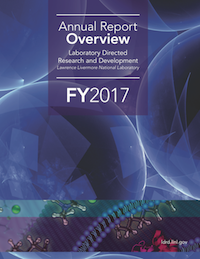The LDRD FY17 annual report contains two parts: an overview and individual project reports summarizing the accomplishments of all projects that were funded in FY17.
The overview introduces Lawrence Livermore National Laboratory and the LDRD Program, describing the Program’s structure and management and providing an update on oversight issues, portfolio statistics, highlights of accomplishments in 2017, and metrics of performance.
The individual project reports represent all the LDRD projects funded this year. They are of two types: progress reports and final reports.
- Progress reports are submitted by principal investigators of projects that will continue into FY2018. They describe the project; its relevance to DOE, NNSA, and Laboratory missions; technical progress achieved in 2017; and a selection of publications and presentations produced from this year’s research.
- Final reports of projects that concluded in 2017 contain a detailed summation that is technical in nature. They contain an abstract; a description of the project’s background and objectives; a detailed summary of the scientific approach taken and the results achieved; and the responsiveness of the project to DOE, NNSA, and Laboratory missions. References and a cumulative list of the publications and presentations produced over the project’s duration are also provided.
Project reports are presented by field of research and organized by year and type, whether exploratory research (ER), a feasibility study (FS), the winner of a Laboratory-wide competition (LW), or a strategic initiative (SI). These types are described in the next section.
Every project is assigned a three-element tracking code:
- The first element is the fiscal year in which the project began.
- The second represents project type.
- The third identifies the serial number of the project within its fiscal year.
For example, the tracking code “16-FS-001” identifies a feasibility study that began in FY16, with a serial number of 001.
Note that some project reports are withheld from publication due to classification, but are available through the appropriate channels.






